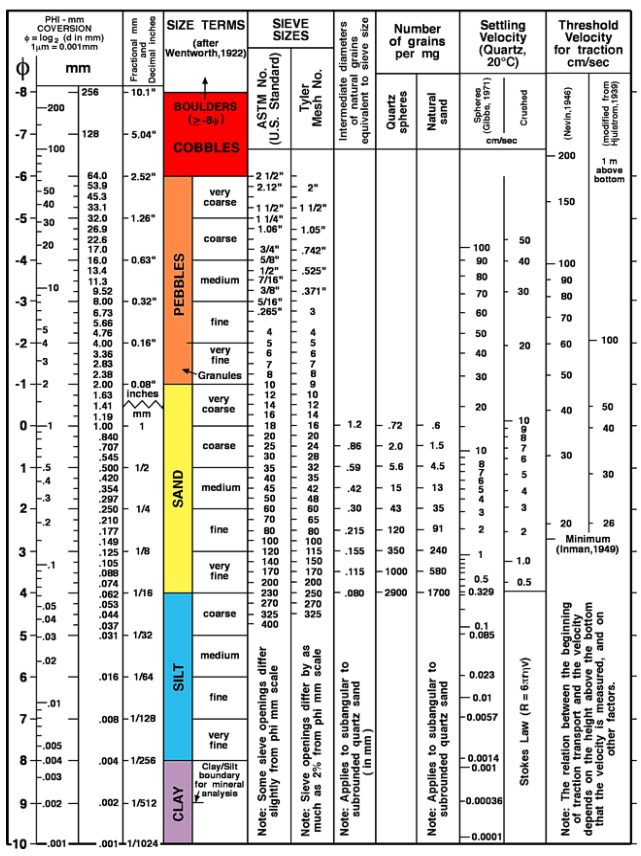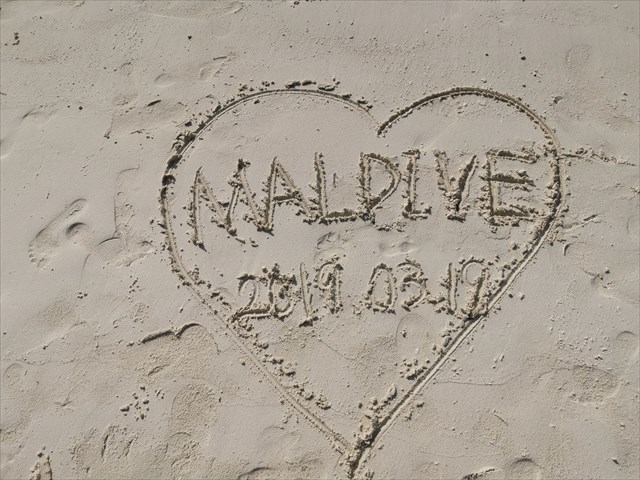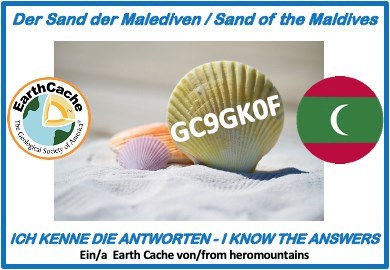

Willkommen auf den Malediven, willkommen in Male!
Wir verbrachten schon mehrere Urlaube auf auf eine dieser traumhaften Malediven Inseln.
Auch besuchten wir dabei auch die Hauptstadt Male.
Uns begeisterte, neben vielen anderen tollen Dingen, natürlich auch der schöne weisse Sand.
Das hat mich zu der Idee gebracht hier einen EC zu diesem Thema auszulegen.
So hoffe ich hier einen lehrreichen EC anzubieten zu können der Euch Spaß macht.
Hier nun einige allgemeine Informationen zu der Insel Male im indischen Ozean.
Die Stadt ist nicht nur die bevölkerungsreichste Stadt der Malediven, sondern auch die am dichtesten besiedelte Hauptstadt der Welt. Die Malediven sind bekannt für Inseln voller Sand und Palmen, die von türkisfarbenem Wasser und Korallengärten umgeben sind, aber Malé ist eine Ausnahme davon. Asphaltierte Straßen voller Geschäftsleute und Autos, umgeben von Wolkenkratzern, die internationale Unternehmen beherbergen, sind eine typische Erscheinung. Hier kann man Fischer beobachten, die ihren täglichen Fang verkaufen, und den Muezzin hören, der die religiösen Malediver zum Gebet in die Moschee ruft.Da Malé nur 8,3 km⊃2; groß ist, können Sie die Insel zu Fuß erkunden, ohne öffentliche Verkehrsmittel benutzen zu müssen. Beginnen Sie Ihre Reiseroute am Hafen und beginnen Sie mit dem Büro des Präsidenten. Leider ist ein Besuch im Inneren des Gebäudes nicht erlaubt. Einige Schritte weiter sehen Sie Hukuru Miskiy, die Freitagsmoschee von Malé. Sie wurde 1658 aus Korallensteinen mit der arabischen Kalligraphie erbaut. Setzen Sie Ihren Stadtrundgang fort, indem Sie zum Sultanspark, einem der wenigen Parks und Grünflächen von Malé, spazieren gehen. In diesem Gebiet befand sich einst der Königspalast, der im 16. Jahrhundert abgerissen wurde. Ein Teil davon ist noch erhalten und beherbergt heute das Nationalmuseum mit einer großen Auswahl an archäologischen Funden und Gegenständen aus der Geschichte der Malediven. Der Rest des Geländes ist ein wunderschöner Park. Zu empfehlen ist auch an der Großfreitagsmoschee, die 1984 erbaut wurde, vorbei zu gehen. Sie liegt direkt neben der Souvenirstraße. Hier können Sie alle typischen Erinnerungsstücke wie Postkarten, Magnete und Schmuck kaufen. Beenden Sie Ihren Stadtrundgang durch Malé auf dem lokalen Markt und dem Fischmarkt, wo Sie den Malediviern bei der Arbeit zuschauen können. Sehen Sie sich die Fische in allen Größen an, die direkt aus dem Meer auf den Markt gebracht werden, darunter Schwertfisch und Tintenfisch. Auf dem lokalen Markt finden Sie alle Arten von Gemüse und Obst, meist importiert, aber auch verschiedene Gewürze und lokale Schokolade. Nach Ihrer Besichtigungstour können Sie sich am künstlichen Strand von Malé entspannen. Bitte bedenken Sie, dass die Einheimischen auch am Strand und im Wasser ihren Körper bedecken und Sie in Malé keine kurze Badekleidung tragen dürfen.
Korngröße
Korngröße, bezeichnetden Äquivalentdurchmesser von Teilchen (Körnern) klastischer Sedimente (Produkte von Verwitterung und mechanischer Umlagerung) und Bodenpartikeln.Es werden verschiedene Korngrößeneinteilungen verwendet. Die Korngrößeneinteilung nach DIN 4022 unterscheidet Ton, Schluff (Silt), Sand, Kies und Steine. Die Korngrößeneinteilungnach Udden & Wenthworth, modifiziert nach Doeglas, beinhaltet clay (Ton), silt (Silt), sand (Sand), granules, pebbles, cobbles (Kies) und boulders (Steine). Die beiden genannten Skalen benutzen als Einheit Millimeter. Eine arithmetische Skala ist die Korngrößeneinteilung nach Phi als logarithmische Transformation der Udden-Wenthworth-Skala.
wobei d = Korngröße in Millimetern. Korngrößen können mit unterschiedlichen Methoden bestimmt werden, wie z.B. durch Siebanalyse, Sedimentationsanalysen oder optische Verfahren. Zu bedenken ist stets, daß bei der Bestimmung aus Dünnschliffen nur ein zweidimensionaler Anschnitt erfaßt wird, was bei komplizierteren Kornformen erhebliche Probleme erzeugen kann. Standardverfahren zur Bestimmung von Korngrößen im Dünnschliff ist das Sehnenschnittverfahren. Folgende Einteilung nach der mittleren Korngröße hat sich für die Geländeansprache international weitgehend durchgesetzt: feinkörnig: 1 mm, mittelkörnig: 1-5 mm, grobkörnig >5 mm. In Deutschland auch gebräuchlich ist die Korngrößeneinteilung für Kristallingesteine nach Teuscher.
Doch nun zum Sand und seiner Klassifizierung
EURE AUFGABE ZUM CACHE:
1.) Wie viele Arten & Größen von Sedimenten findest Du?
Sortiere bitte die Sedimente anhand der Wentworth-Skala.

2.) Untersuche jedes der Sedimente sehr genau und prüfe um welches Mineral es sich handelt.
A) Monominerale (bestehend aus nur einer Materialart)
B) Polyminerale (bestehend aus mehreren Materialarten)
3.) Lass trocken Sand durch die Hande rieseln, nun Hände abklopfen. Welches Hautgefühl bleibt ?
A) Das Gefühl als wären die Hande wie von Schleifpapier aufgeraut.
B) Das Gefühl von Puderzucker zwischen den Fingern
C) Das Gefühl von Feuchtigkeit obwohl die Hände vorher trocken waren.
Beschreibe in eigenen Worten warum dieses so ist.
4.) Erstelle für den Log ein Logfoto mit einem Sandkorn in Deiner Hand & Male im Hintergrund.
Optional auch ein Herz im Sand inkl. Datum + dein GC - Namen.
Beispiel:

Natürlich freuen ich mich über jedes weitere eingestellte Foto um das Reisefieber zu entfachen.
Ich wünsche euch viel Spaß bei diesem EC und einen schöne Zeit auf diesen tollen Inseln.
Schickt mir Eure drei Antworten und stellt das Logfotos mit ein.
Dann dürft ihr sofort loggen, sollten die Antworten nicht stimmen werde ich mich bei Euch melden.
Sollte ich keine Antworten erhalten oder das Logfotos fehlen, werde ich leider Eure logs löschen müssen.
.........................

Welcome to the Maldives, welcome to Male!
We spent already several a vacation on this dreamlike Maldives islands.
We also visited the capital Male.
We were thrilled, in addition to the many other great things, of course, the beautiful white sand.
This has brought me to the idea here an EC to this topic.
So I hope to be able to offer here an instructive EC that makes you fun.
Here now some general information about the island of Male in the Indian Ocean.
The city is not only the most populous city in the Maldives, but also the most densely populated capital in the world. The Maldives is known for islands full of sand and palm trees surrounded by turquoise waters and coral gardens, but Malé is an exception to this. Asphalted streets full of businessmen and cars surrounded by skyscrapers housing international companies are a typical sight. Here you can watch fishermen selling their daily catch and hear the muezzin calling religious Maldivians to prayer in the mosque.Since Malé is only 8.3 square kilometers, you can explore the island on foot without having to use public transportation. Start your itinerary at the port and begin with the President's office. Unfortunately, visiting inside the building is not allowed. A few steps further, you will see Hukuru Miskiy, the Friday Mosque of Malé. It was built in 1658 from coral stones with Arabic calligraphy. Continue your city tour by walking to Sultan Park, one of Malé's few parks and green spaces. This area was once home to the royal palace, which was demolished in the 16th century. Part of it is still preserved and now houses the National Museum with a large selection of archaeological finds and objects from the history of the Maldives. The rest of the site is a beautiful park. It is also recommended to pass by the Great Friday Mosque, which was built in 1984. It is located right next to the souvenir street. Here you can buy all the typical souvenirs like postcards, magnets and jewelry. End your Malé city tour at the local market and fish market, where you can watch Maldivians at work. Check out the fish of all sizes brought directly from the sea to the market, including swordfish and squid. At the local market you will find all kinds of vegetables and fruits, mostly imported, but also various spices and local chocolate. After your sightseeing tour, you can relax on Malé's artificial beach. Please keep in mind that the locals also cover their bodies on the beach and in the water and you are not allowed to wear short swimwear in Malé.
Grain size
Grain size is the equivalent diameter of particles (grains) of clastic sediments (products of weathering and mechanical rearrangement) and soil particles. The particle size classification according to DIN 4022 distinguishes between clay, silt, sand, gravel and stones. The grain size classification according to Udden & Wenthworth, modified after Doeglas, includes clay, silt, sand, granules, pebbles, cobbles and boulders. Both of the above scales use millimeters as the unit. An arithmetic scale is the grain size division according to Phi as a logarithmic transformation of the Udden-Wenthworth scale.
where d = grain size in millimeters. Grain sizes can be determined by different methods, such as sieve analysis, sedimentation analysis or optical methods. It should always be borne in mind that when determining from thin sections, only a two-dimensional section is recorded, which can cause considerable problems with more complicated grain shapes. The standard method for determining grain sizes in thin sections is the chordal section method. The following classification according to mean grain size has become widely accepted internationally for terrain analysis: fine-grained: 1 mm, medium-grained: 1-5 mm, coarse-grained >5 mm. In Germany, the grain size classification for crystalline rocks according to Teuscher is also commonly used.
But now to the sand, and its classification
YOUR TASK FOR THE CACHE:
1.) How many types & size of sediments do you find?
Please sort the sediments according to the Wentworth scale.

2.) Examine each of the sediments very carefully and check which mineral it is.
A.) Monomineral (consisting of only one type of material)
B.) Polyminerals (consisting of several types of material)
3.) Let dry sand trickle through your hands, then pat hands. What feeling remains on the skin?
A) The feeling as if the hands were roughened by sandpaper.
B) The feeling of powdered sugar between the fingers.
C) The feeling of moisture, although the hands were dry before.
Describe in your own words why it is like that.
4.) Create a log photo for the log with a grain of sand in your hand & the City in the background
Optionally also a heart in the sand incl. the date + your GC- name.
Sample:

Of course, I am happy about every other posted photo to spark the travel fever.
I wish you a lot of fun with this EC and a nice time on this great islands.
Send me your four answers and include the log photos
Then you may log immediately, if the answers are not correct I will contact you.
If I do not receive any answers or the log photo is missing, I will have to delete your logs.
Wer möchte kann das Banner in sein Profil einbauen.
Whoever wants to can add the banners to their own profile.

Füge dazu einfach folgenden Code in Dein Profil ein: / Just add the following code to your profile:
<a href="http://coord.info/GC9GK0F" target="_blank"><img src="https://s3.amazonaws.com/gs-geo-images/863b460b-ef00-42a0-b9e4-2c94438142a7_l.jpg?rnd=0.7346961" border="0" /></a>
Für die ersten drei Finder gibt es eine kleine Tabelle! / For the first three finders there is a small table!
1.) Lierath
2.) Cignana / nyuszifül
3.) LaPaLeo
